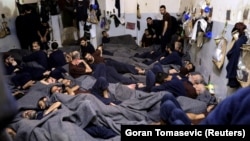On March 23, 2019, the ISIS terrorist group lost the last territories it once held in Iraq and Syria. In the aftermath of ISIS’s last stand against the Global Coalition to Defeat ISIS and its local partner, the Syrian Democratic Forces, thousands of fighters were detained, as were tens of thousands of people caught up in the fighting, including families of the fighters. While many of these people are Syrian or Iraqi, thousands more are nationals of third countries, or children born in Syria to parents born abroad. They remain in al-Hol or Roj camps, waiting to be repatriated to their home countries. The fighters remain in SDF detention facilities.
Some of these foreign populations, particularly the women and children, have been repatriated home, thousands still live in displacement camps or detention centers in northeastern Syria. “We cannot ignore the serious concerns posed by the detainee and displaced person populations in northeast Syria, because those concerns will not ignore us,” said Ian Moss, United States Deputy Coordinator for Counterterrorism with responsibility for Terrorist Detention and Countering Violent Extremism.
The home countries of these detainees are often unwilling or slow to repatriate, rehabilitate, reintegrate, and where appropriate prosecute their citizens. Nonetheless, the pace has picked up in 2022, with over 3,000 foreign nationals repatriated from northeast Syria, equaling the numbers of the three prior years put together, said Deputy Coordinator Moss.
“Repatriating these individuals ultimately poses a much lower risk than leaving them in Syria,” said Deputy Coordinator Moss. “10,000 ISIS fighters remain in custody, the largest concentration of detained terrorists in the world.”
And ISIS will look to fill the holes in its ranks by attempting to recruit these detainees. The best way to prevent that is to move them out of Syria.
“Repatriation, rehabilitation, reintegration, and – where appropriate – prosecution and incarceration are the only durable solutions to this problem,” said Deputy Coordinator Moss.
“The United States stands ready to help, not just with the logistics but also by facilitating the sharing of best practices and expertise,” he said. “Additionally, our military partners have access to an enormous amount of battlefield evidence from the Coalition’s counter-ISIS campaign.”
“This can be done,” said Deputy Coordinator Moss. “Together we can continue making the type of progress that has already made us safer. But there is more to do, and we cannot let up.”














